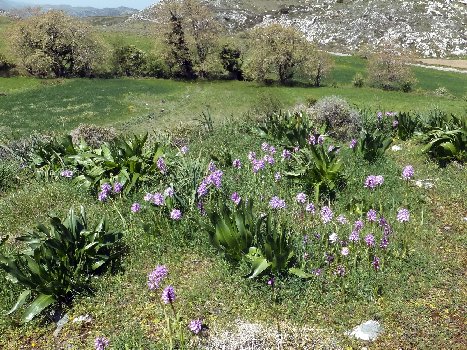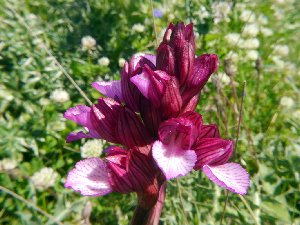|
We had been to Crete once before, at Agios Nicolaus, but it was during May and way too late for any but a few stragglers in terms of orchids. This time we chose Rethymno, the opposite side of Heraklion, as a base having had some very good information following an online appeal for advice. Many thanks to those who helped. Initially I wanted very late March through the beginning of April for the visit, but that included Easter weekend, which could make flights and accommodation problematic. So 7th - 17th April was chosen, and guess what? That coincided with the Orthodox Easter, and our first full day was spent looking at nearly everywhere being closed for the day. In fact, in the month before we left I was worrying that perhaps we had booked the trip a week or two too late, and may miss the orchids. Not only was social media blossoming with fantastic orchid pictures from all over the Mediterranean region, but orchids in bud in the UK were emerging. Then on the day before the flight images of orchids in flower on nearby Rhodes appeared, which quelled my doubts. We were perhaps a few days past the best, but still so much to see.
We hired a car for five days, having planned where to go for orchids and incorporating other places to visit. Crete does have some great archaeological sites. Unlike Corfu, where orchids seem to grow almost anywhere, including in Corfu Town itself, on Crete they did not seem to grow outside well defined areas, but within those they were very prolific. We saw more in terms of numbers and species than anywhere else. The orchid area we concentrated on was centred on the small town of Spili. This place seems to exist for the benefit of tourists and was useful in providing cafes and bars and of course WCs - early in the season many roadside tavernas are just not open and cannot be relied on.
In preparation I bought and studied Orchids of Crete and Dodecanese by Horst and Gisela Kreutzscmar, (and abandoned Delforge for this trip). I can recommend this book, especially as it also tempts you to consider Rhodes in the future.
Crete, however, is not for the nervous driver. The roads have bend after bend, up and downhill, often with an unguarded down-slope on one side and a precipitous rock face on the other. Debris from the latter litters the roadside, and potholes in the tarmac are a big feature of Cretan roads. Orchid hunting can take you into the wilds, where the most common vehicle met would be a battered Isuzu pick-up truck. You can find ancient farmers sat side-saddle on a mule, leading goats to pasture, or a litter of piglets grubbing around in the roadside ditch.

Most of the sites we visited were phrygana; the rocky slopes with scattered rocks and tough, low, shrubby vegetation kept in check by grazing goats. That orchids are growing there is not always obvious from just a few yards away, but once you start climbing they can be found between the shrubs in ever increasing numbers. Most days we had bright sunshine. Body sun protection was essential, but the brightness did make photography difficult. As did the number of times that the best view of an orchid flower was the one facing directly at a spiky bush. Crete is also awash with other wild flowers in the spring. If my interests were broadened beyond orchids I doubt that 10 days intensive botanising would have done this area of the island justice.
All in all a Cretan holiday looking for orchids around Spili is a treat not to be missed if at possible.
   
|
